Biking Trial of Defensive Architecture
Practical Information
- Detailed InformationZwińRozwiń
- Object type:
- Bicycle
- Difficulty of the route:
- Beginners
- Route route:
- Buskozdroj
- Jedrzejow
- Kielecki
- Konskie
- Ostrowiec
- Pinczow
- Staszow
- Locations on the route:
- Końskie - Modliszewice - Kazanów - Chełmce - Podzamcze Piekoszowskie - Jaskinia Raj - Chęciny - Podzamcze Chęcińskie - Bolmin - Małogoszcz - Sobków - Mokrsko - Imielno - Pińczów - Chroberz - Stradów - Pełczyska - Wiślica - Szczaworyż - Stopnica - Rytwiany
- Attractions on the route:
- Palace nad Park Complex in Końskie, church of Saint Mikołaj in Końskie, Palace in Modliszewice, Ruins of the Palace in Podzamcze Piekoszowskie, Jaskinia Raj, Ruins of the Castle in Chęciny, Bernardian Convent, Franciscan"s Monastery and Church, Niemczówk
- Route length:
- 500km
- Tourist region:
- Busko-Zdrój Region
- Jędrzejów Region
- Kielce Region
- Końskie Region
- Ostrowiec Świętokrzyski Region
- Pińczów Region
- Staszów Region
- Organizer name:
- Regional Tourism Organization of Świętokrzyskie Voivodeship
- Organizer data:
- 25-033 Kielce, ul. Ściegiennego 2 32
- Phone:
- +48 41 348 00 60
- fax:
- +48 41 348 00 60
- E-mail:
- informacja@swietokrzyskie.travel
Description
The roar of artillery, whistling a shot fired from bows, fire, smoke, uplifting songs of warriors - just imagine a pre-battle for centuries. Defenders. hidden within the walls of castles and fortifications as castles and invaders plundering, robbering and raping - all of the past. Now, to feel the real winner of the ramparts and the castle hill, just get on your bike and follow "Biking Trial of Defensive Architecture”, leading the land Province. During this cycling trip, we can pass the assault, among others: the Palace of Krakow Bishops in Kielce and royal castles in Sandomierz, Chęciny and Szydlow, the palace-fortress "Krzyżtopór" in Ujazd, the palace in Kurozwęki or Sobków. The trail is the perfect idea for active spending of free time for supporters of rest on two wheels, as well as for military enthusiasts and Polish history. There is also a real challenge for the winners ...
Course: Końskie - Modliszewice - Kazanów - Chełmce - Podzamcze Piekoszowskie - Jaskinia Raj - Chęciny - Podzamcze Chęcińskie - Bolmin - Małogoszcz - Sobków - Mokrsko - Imielno - Pińczów - Chroberz - Stradów - Pełczyska - Wiślica - Szczaworyż - Stopnica - Rytwiany - Kurozwęki - Szydłów - Rembów - Ujazd - Konary-Kolonia - Ossolin - Samborzec - Sandomierz - Kichary - Międzygórz - Tudorów - Opatów - Ptkanów - Podgrodzie - Ćmielów - Grzegorzowice - Dębno - Bodzentyn – Kielce
Lenght: 500,5 km
Colour: black
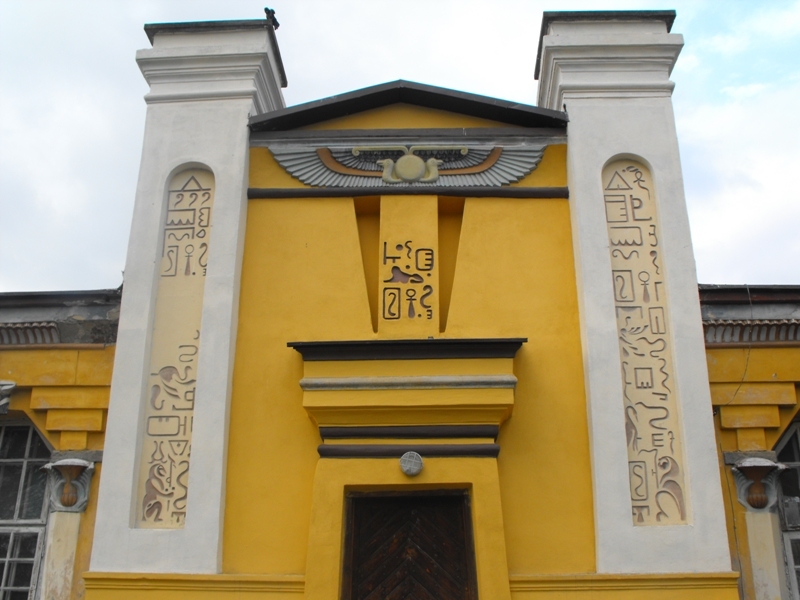 photo A.Kowalska
photo A.Kowalska Końskie – miedieval town, extended during the 17th and 18th century by Małachowscy Family. One should notice Palace and Park Complex. It was raised in the 1740s for Jan Małachowski, who planned to erect a huge residence with two adjacent wings. The wings were built , but the main building was never started. The wings were reshaped in the 19th century. Today the main attraction of the complex is its park with a neoclassical glorietta, Greek temple, Egyptian orangery, and a garden arbor. In its southern part there is a neo-Gothic Domek Wnuczętów (Grandkids" House), two round towers an a little chapel. Worth to see is church of Saints Mikołaj and Wojciech. The collegiate church in Końskie was erected in the years 1492-1520. It was remodelled in the early 20th century, when a new tower was built and the western part of the nave as well as the roof-top were added. The late-Renaissance tombstone of Hieronim Koniecki from 1564 was placed on the church wall. Its bas-relief features a resting knight. There is a sundial (early 17th c.) in the presbytery and a late-Romanesque tympanum decorates its southern entrance.
Modliszewice – one should notice the ruins of castle from 16. century, designed by Santi Gucci thanks to Andrzej Modliszewski foundation. The castle is picturesquely located on the island surrounded by water moat from the North and pond from the South. Made of bricks and stones, has two storeys and two basteas. To the castle one can get through the bridge and gate in the north.
Kazanów – remains of the Kazanowski manor house built in 16. century and complex of Bernardine monastery from 17. century. The church was built on the place former timber church from 1694, founded by Izabela Lipska-Lamckorońska. Complex of Bernardine monastery are added to the church.
Chełmce – worth to see is the church of Saint Mikołaj and Maria Magdalena, built between 1620-1665 in the style of the early-Baroque by Jan Tarło the Lublin governor and manor house of Jan Stanisław Tarło from 17. century, one of the oldest defense buildings in Świętokrzyskie Mountains.
Podzamcze Piekoszowskie - this little village hosts ruins of the palace once belonging to the powerful Tarło family. Castellan Jan Tarło had an early-Baroque palace erected here in the years 1645-1650. It was patterned on the palace of Cracovian bishops in Kielce. Damaged by fire in the mid-19th century, the palace was never restored. Some windows still have their frames and four characteristic towers, once with spiral staircases inside, can be identified.
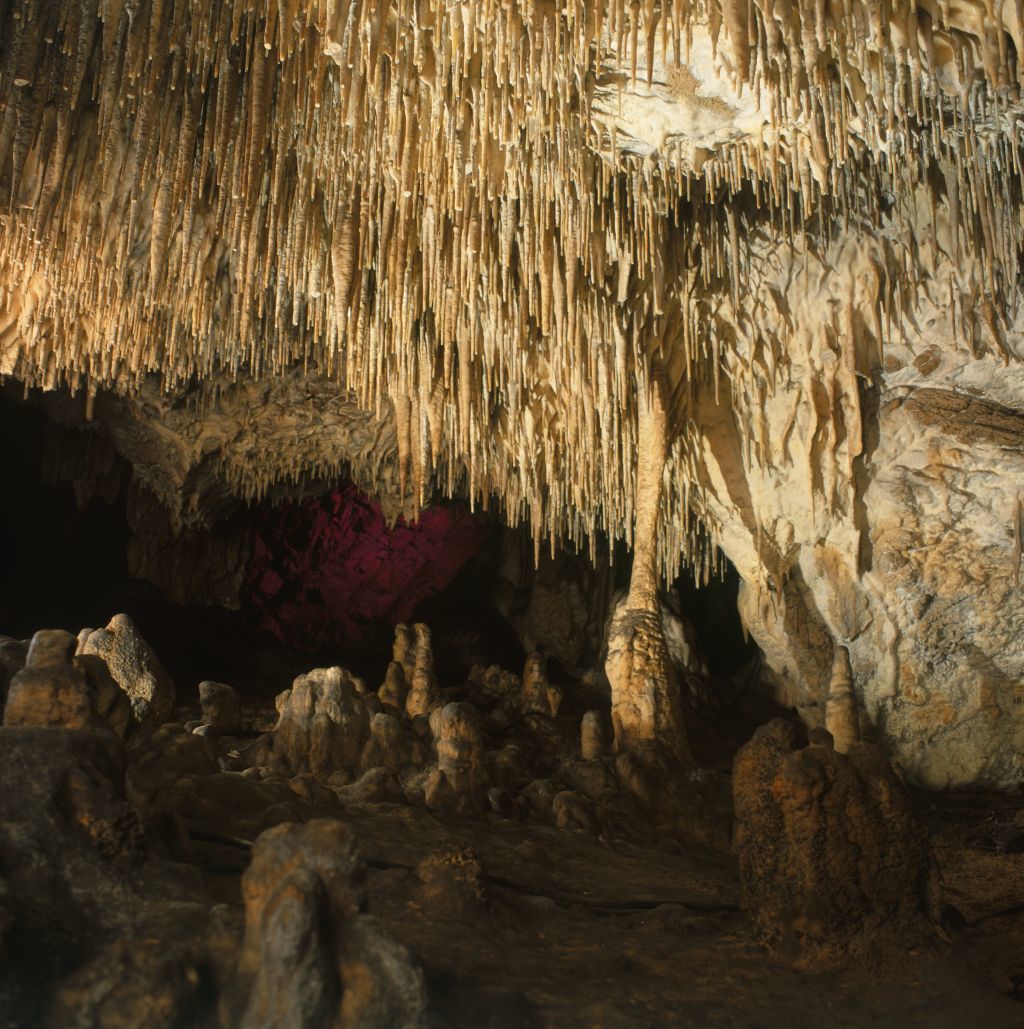 photo P. Pierściński
photo P. Pierściński Raj Cave - taking a trip all around the Świętokrzyski Region, one only needs to turn off the E-7 motorway from Kraków to Kielce into a side roads to get to the very centre of “Raj” being the most beautiful cave in Poland. Nature has for ages created its underground complex of breathtaking tunnels and chambers decorated with hundreds of stalagmites, stalactites, pillars and pisoids of various shapes and forms. A 180-metre underground route was opened especially for tourists, who may admire the fairy- tale like underground world. The entrance of the cave houses an exhibition with its restored camp of a Neanderthal family, three natural sized figures and remains of prehistoric animals such as the mammoth, hairy rhinoceros and cave bear.
Chęciny - royal town till the 18th century, and the seat of a starosta who managed the district in king"s name. Conventions of knights and gentry gathered in Chęciny. First resolutions were voted here in the years 1310-1331.Municipal rights were granted to Chęciny in the 14th century. The town prospered under the rule of king Kazimierz Wielki (Casimir the Great). Worth to see is castle - rected on the limestone hill in 1306 by king Władysław Łokietek (Ladislaus the Short), the castle was designated to serve Cracovian bishop Jan Muskaty. In subsequent centuries it often served royal widows as a refuge. Here stayed Adelajda, the second wife of king Kazimierz Wielki, his sister Elżbieta, and the wife of king Zygmunt Stary (Sigismond the Old) queen Bona. After the Grunwald battle (1410), some important Teutonic Knights were among prisoners of the castle dungeon arranged in its basement. Enlarged in the 14th century, the castle became of Poland"s most powerful strongholds. It never regained its former splendor after ravages suffered during the Swedish invasion (17th c.) and the Partitions (1772-1795). Its elongated structure can be divided into two parts. The older (upper) one embellished by two round towers and the younger (lower) one with the quadrilateral tower built in the 15th century. The lower castle was used for administration purposes. On the other hand, on should notice Franciscan Monastery Complex. The monastery was founded by king Kazimierz Wielki in 1368. Ruined by Protestants and Swedes, it was rebuilt and enlarges in the later periods to acquire new cloisters, chapels and additional storeys. It was taken away from the Franciscans at the beginning of the 19th century and became a prison. Synagogue - The brick building was built after 1638. Preserved is the bimah made of black marble with the Chęciny marble inlays and frescoes.
Podzamcze Chęcińskie – worth to see is fortified manor house, built and expanded by governor of Chęciny. In park one can see a monument of nature: beautiful avenue of lime and a Baroque gate in the form of a triumphal arch. According to legend, it was built for returning from Vienna, king Jan Sobieski.
Bolmin – the small village famous for church of The Blessed Virgin Mary from 1604 and ruins of the manor house erected at the turn of 16. and 17. century, rebuilt during the 19. and 20. century.
Małogoszcz –in the Middle Ages the town functioned as a castellany. Nowadays, one should notice church of the
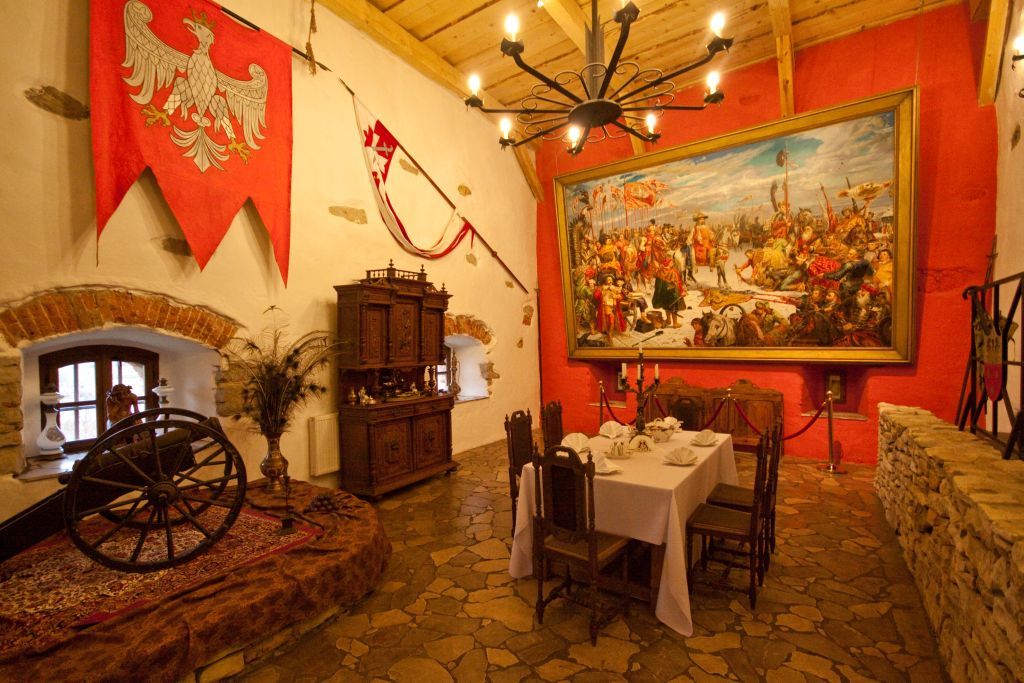 photo M. Maciążek
photo M. Maciążek Assumption of The Blessed Virgin Mary (1591-1595), Renaissance presbytery erected at the turn of 16. and 17. century, cemetery church from 1595 and monument of Tadeusz Kościuszko.
Sobków - In the late 16th century Stanisław Sobek of Sulejów (Brochwicz coat-of-arms), castellan of Sandomierz and treasurer of the crown, started construction of a castle upon River Nida and founded the town of Sobków. Well-preserved part of the stronghold was adapted for tourist purposes and became a real attraction for visitors. There is a nice restaurant and a hotel which offers overnight stays in original chambers located in place of the former treasury.
Mokrsko – interesting ruins of the late-Gothic castle built in the years 1519-1526 by the Grand Marshal of the Crown Piotr Kmita. In the 18. century, fell into ruin.
Pińczów – a town in the heart of Ponidzie located on the River Nida, was bought and developed by Zbigniew Oleśnicki, a Cracow bishop, and was to become the family seat of the Oleśnicki Family. Mikołaj Oleśnicki made Pińczów a centre of reformation in Małopolska. It was in Pińczów, the seat of the Polish Brethren (Arians) that the first translation of the Bible into Polish was made. The Bible is referred to as brzeska, radziwiłłowska or pińczowska Bible. Since the 17th century Pińczów had been the capital of the Piƒczowska Ordination established by the family of Myszkowski. It was there that Santi Gucci, the king Stefan Batory’s and Zygmunt III Waza’s court architect ran his stonemasonry workshop. The local junior high school was attended by the future parish priest of Krzyżanowice and Pińczów and Hugo Kołłątaj, who was a co-author of the Constitution of May 3, 1791. The following historical buildings are worth seeing: the complex of the Pauline monastery buildings, the church and monastery of the Order of the Reformati, a Renaissance synagogue, the Wielkopolski Family Palace, the House on Mirów i.e. a printing house of the Arian Brothers. Standing on the top of St. Anne’s Mountain with its free-standing dome chapel build of local “pińczak” stone and designed by Gucci, one can admire meanders of the River Nida and meadows, on which a gliding school was located. There is also a station of the Narrow-Gauge Train “Ciuchcia Express Ponidzie”.
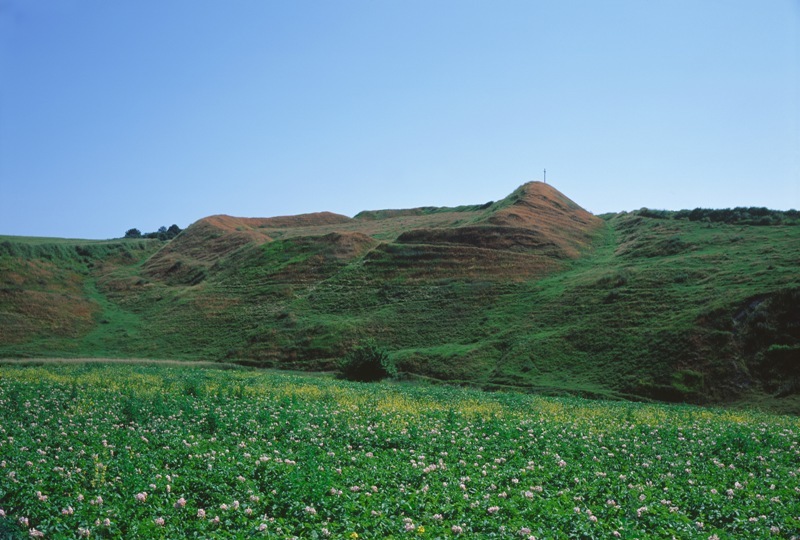 photo P. Pierściński
photo P. Pierściński Stradów – village is known from early medieval and the largest tribal settlement in Poland, founded probably in the 8th century. Reaching several meters embankments and depressions moat have been survived until now. In good weather one can see the peaks of the Tatra Mountains. Worthy of note is the wooden church of Saint Bartłomiej, built in 1699, rebuilt in the 19. century. The church has log construction with larch and baroque fitting. There is also a 19. century belfry.
Pełczyska – town known primarily from the complex of Celtic settlement in the range of a few settlements, cemeteries of various periods and remains of a rampart. Besides, you can see the church. Saint Wojciech of the 19. century, which is fitted in rococo style.
Wiślica - located in the Ponidzie, was founded at least in 9th century. The legends have it that Wiślimir, the duke, was its founder and Wiślica derived its name from him. Wiślica was one of the towns of the state of Wiślanie, which was incorporated by Mieszko I in 990 in his domain of Polanie. Some sources say that it was here that the duke of the Wiślanie accepted Christianity there in 880. A gypsum baptismal font, which has a diameter of 4.5 m and depth of 37 cm and was used for collective baptism, has been preserved up to now. Above the city there soars the edifice of the Collegiate Church today referred to as Minor Basilica, which was erected by Casmir the Great. Owing to its sculpture of the Madonna of Łokietek dating back to 1300, the temple is known as a sanctuary of the Mother of God of Wiślica. The vaults of the collegiate contain relics of two Romanesque temples dating back to the 12th century and 13th century as well as a famous plate depicting praying figures (“Płyta Orantów”) dating back to 1170 and unique on the European scale. In 1347 in Wiślica so-called Wiślica Statutes were announced. It was the first codification of the Polish law. The following historical buildings are worth seeing within the historic urban development: Jan Długosz’s House of 1460 now housing exhibitions of the Regional Museum and a Gothic belfry and numerous historic tenement houses.
Szczaworyż - worth to see is built in the late- Renaissance church of Saint James the Elder, built in1630, on the site of an older church. The original Gothic choir and late baroque chapels have been preserved until now. Inside there is a Baroque epitaph of James and Barbara Kosteccy, and fragments of polychrome of the 16. century. Next to the church one can see the church chapel of Saint Mary of the Immaculate Conception. An interesting relic of the past is the Early medieval refugial rampart from 9. century.
Stopnica - medieval village, in which valuable monument is the Gothic Parish Church of Saints App. Piotr and
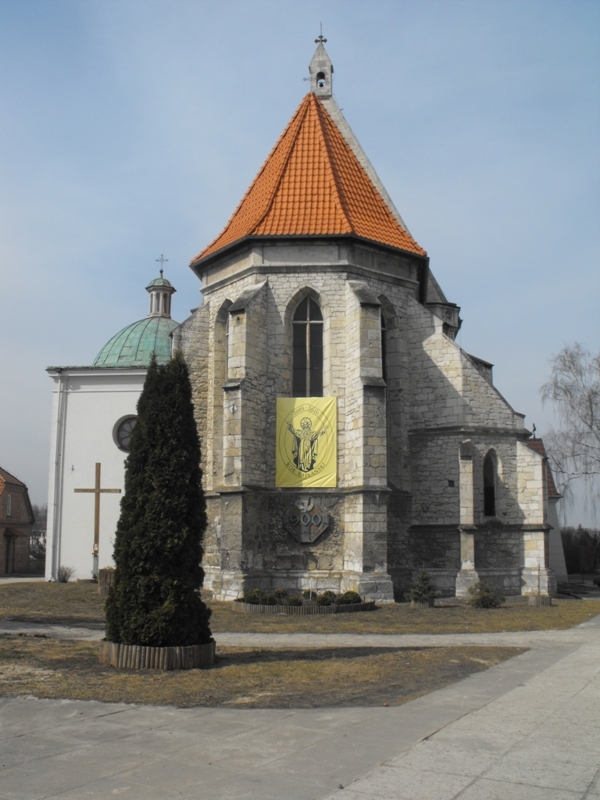 photo A. Kowalska
photo A. Kowalska Paweł, founded by King Kazimierz the Great in the 14. century. Parish Church is a build with stone blocks with two chapels: the late Gothic and early Baroque. One can not miss the monastery of fathers Dehonians, built in 1639 by the Christopher and Anna Ossolińscy. In 1944 the Germans blew up the church in the air, and another authority was not allowed to rebuild. Painting of Saint Anthony with Jesus Christ and the head of Christ of the Cross hanging on the main altar of the church.
Rytwiany - the Eremu Silvae Aureae, or the Golden Forest Hermitage, was built near Rytwiany (1624-27) for the Monte Korona Cameldolese congregation. The complex included a church of the Annunciation of the Holy Virgin Mary, monastic and administration buildings as well as ermitorium (16 dwellings for hermits). Today it is the only monastery opened to the public in Poland that has preserved its nearly original 17th century shape. It"s been a year now that the renovated Golden Forest Hermitage functions as a therapeutic center and offers therapeutic and relaxation stays to those who seek spiritual relief and wish to spend some time in silence, solitude, without radio, TV or telephone. The center can accommodate 40 persons in rooms with bath; there is also a fitness room, sauna and a massage center. In the refectory located in the main monastery building home-made dishes are served; they are prepared according to recipes of the European Cameldolese Trail.
Kurozwęki - in the second half of the 14th century in Kurozwęki they erected a castle referred to in a document dating back to 1400 as “castrum Curoswank”. At the turn of next centuries the castle was rebuilt several times and given representative character finally to be converted at the end of the 18th century from an originally dwelling building with a defensive character into a Baroque and Classicistic residence. Presently you cannot miss the castle edifice located in the complex of parks and palaces with its richly decorated five-axle facade and galleried courtyard. It is worth visiting the interior of the Palace in Kurozwęki with its dungeons and stay for a night in its stylish chambers, hothouse or annex. A unique attraction is a herd of over 80 American buffaloes in, which can be admired from the interior of “safari buffalo” carriage. Active leisure lovers may go horse-riding, cycling, play paint-ball or try a rope slide. There are also knight fights, artillery and ancient dancing show organised upon request.
Szydłów - was a settlement situated close to the trade route running along the Vistula River. It was mentioned in the historical records for the first time in1191. Due to its convenient location and historical developments, Szydłów prospered and received its municipal rights from king Władysław I Łokietek in 1329.
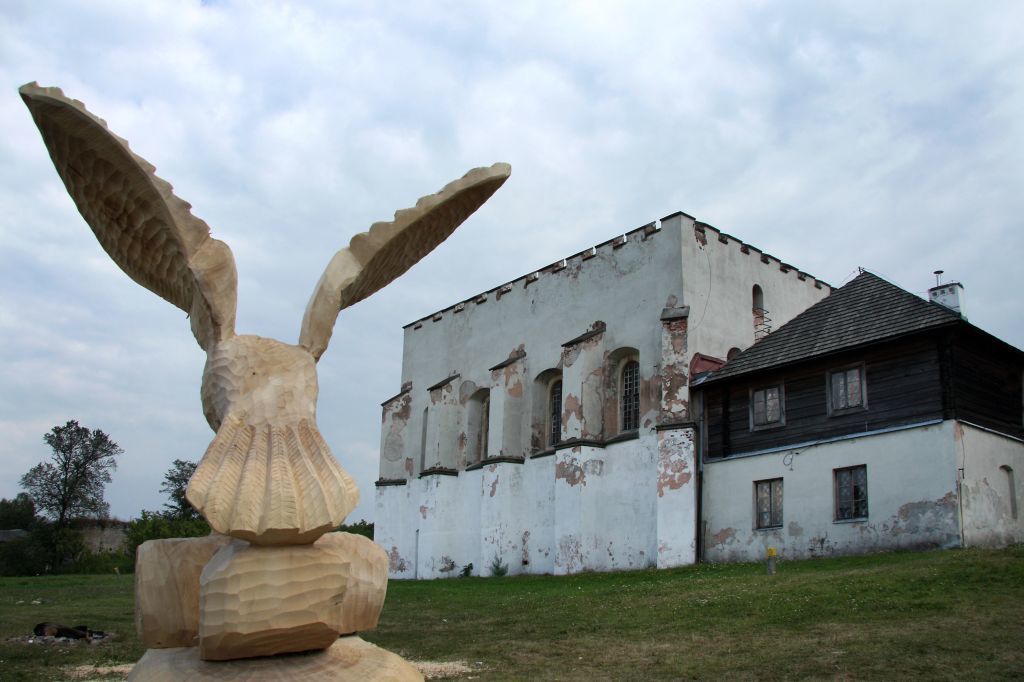 photo M. Maciążek
photo M. Maciążek The castle and St Ladislaus Church were founded by king Kazimierz III Wielki in the mid-14th century. The town was also surrounded by fortifications with the gates: Krakowska, Opatowska and Wodna. The town"s decline started in the 17th century following the fire set up by revolted hired soldiers in 1630, Swedish invasions, and the disastrous "visit" paid by the army of duke György Rákóczi, a Hungarian ally of the Swedes. Szydłów suffered much destruction during the final years of World War II as well. Worth to see are originally Gothic, the Krakowska Gate is the only surviving one of the three gates built in the 14th century in the town"s defensive walls. Its upper parts were later remodeled in the Renaissance style. In place of a wooden church, king Kazimierz III Wielki founded another one dedicated to St Ladislaus in 1355. Next to it stands an old belfry. Only four sections (700m) of the Szydłów defensive walls (14th c.) survived till today. The walls were founded by king Kazimierz III Wielki and the town was added to the network of the country"s strongholds. The main building of the Szydłów castle is in ruin. Of the partly preserved castle premises worth a visit is the Knights" Hall and the Skarbczyk (16th c.), now the seat of the Regional Museum. The synagogue was built of stone in the mid-16th century. The wall-paintings and stucco decorations were added in the 18th century. Arms and foodstuffs were stored in the synagogue building during World War II. It was used for film projections after the war. The Gothic All Saints Church (14th c.) stands outside the city walls. Its interiors are decorated with Gothic frescoes dating from ca. 1375.
Rembów - to this day among the forests the ruins of fourteenth-century fortified castle has been preserved. The building has an irregular shape, adapted to the terrain configuration and consisted of two parts: the lower yard and farm buildings and the top one - fitted with a residential tower, which in case of danger was the final place of refuge. the residential part were cellars.
Ujazd – the town is famous for castle which is located in a little town of Ujazd situated near the south-eastern
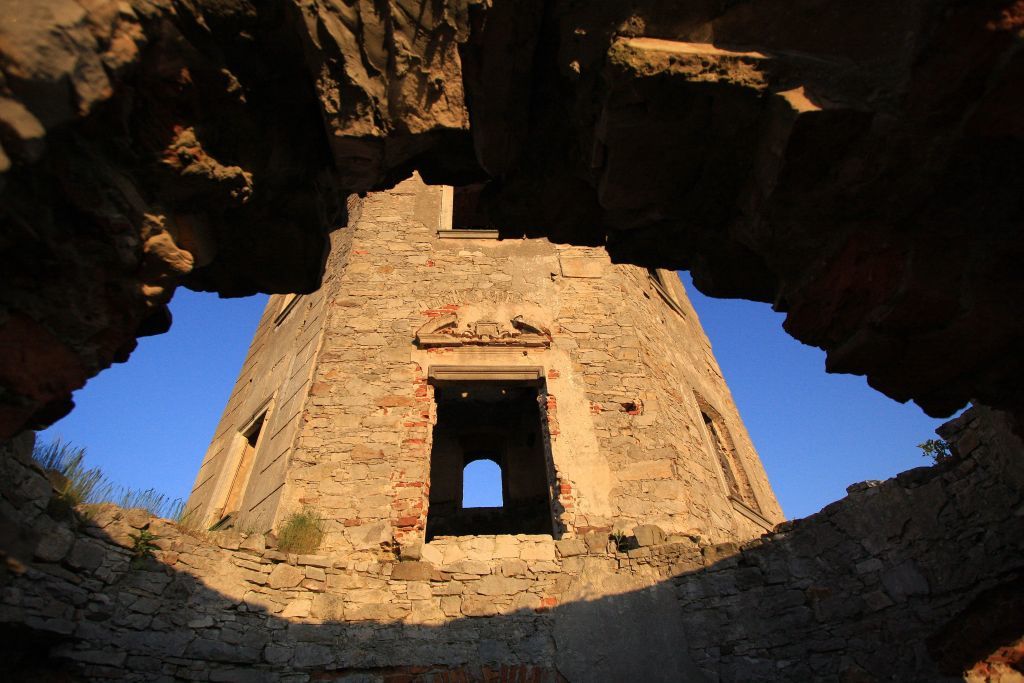 photo K. Pęczalski
photo K. Pęczalski boundary of the Świętokrzyskie Mountains. The castle of Krzyżtopór in Ujazd had a defensive character. Its construction that took 13 years was supervised by Italian architect Lawrence Senes, who also designed the project. Built inside massive stone walls with bastions at the five corners, this mannerist palace embodied the structure of the calendar. It had four towers symbolizing the four seasons and 12 big halls, one for each month. Exactly 52 rooms were built, one for each week in the year, and 356 windows. The building occupied an area of 3.2 acres, its walls were 600-meter-long and its cubature amounted to 70 thousand cubic meters. Marble and mirrors were used in the interiors of the underground stables, while the ball room had an aquarium in place of the ceiling. The water supply installations used water from the local spring, and rooms were heated with warm air coming to them through special air passages.
Konary – one should notice ruins of the castle form 13. century which are situated on the place of former rampart. Probably, the castle was built in Gothic style. During the Władysław Jagiełło reign, it was destroyed as well as in 20. century.
Kolonia Wiązownica – one can see the neo-Gothic palace from 1844, built by the Russian General Basil Pogodin. Local people call the palace "Thanks", because according to legend, General built it for his beautiful wife. Giving it into her hand, he had to say: "In tribute to your charms, I make you thanks." A circular staircase and a curved entry refers to the eastern building. The entrance doors have been preserved with the emblem of the first owners. Worth to see is also late-Classical church of Saint Michael from the first half of the 19. century. In 1916 the church was enlarged with two side chapels and presbytery.
 photo K. Sajecki
photo K. Sajecki Ossolin – the village was Ossolinski’s ancestral nest. In 1635, Chancellor George built a Renaissance residence here. Nowadays, one can see only a stone bridge over a deep arcade ravine and a fragment of the entrance gate. One should notice the chapel from 1640, built on the model of Bethlehem, a dark, tunnel interior, covered with a mound of earth which, according to tradition, imported from Bethlehem.
Samborzec – the most important monument of the village is the church of Holy Trinity, built in the 13th century of the foundation comes from Paweł Samborzec. During the Swedish wars destroyed and rebuilt in the years 1688 to 1691. Baroque church is a remnant of the original Romanesque style is semi-circular apse. Fitting comes from the 17.-18.century. In view of the ancient settlement, the Samborzec area is constantly examined by archaeologists.
Sandomierz - occupying a few hills and a high escarpment from which enfolds a splendid view over the Vistula valley, the town has more than 120 monuments of architecture. Most of them date back to the Middle Ages and that"s why Sandomierz is considered a real gem of the Świętokrzyski region. The highlight of the town is its old town with the Renaissance town hall standing in the middle of the market square.
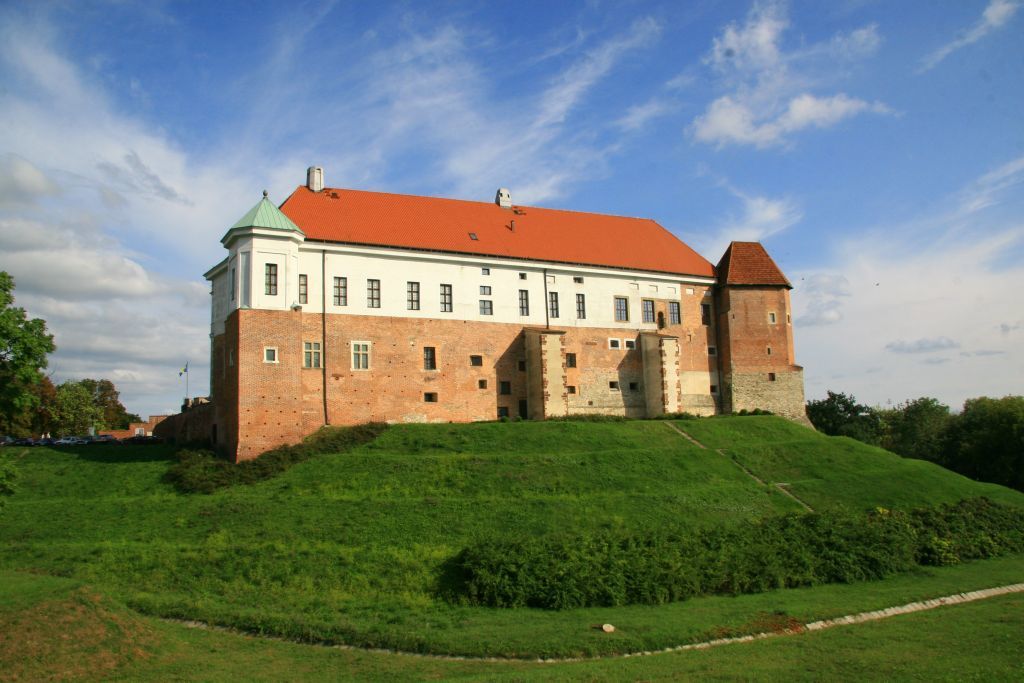
The ground floor of the town hall is occupied by the exhibitions of the Regional Museum; they reveal to us the historical development of Sandomierz. Interesting are old burgher houses that line the market square. Worth a special attention is the Oleśnicki family house (16th c.), Mikołaj Gomółka house (16th c.), St Andrzej Bobola boarding school (17th c.), and the House Under Ciżemka (16th c.). Very beautiful view of the market square can be enjoyed by those who enter the town through Opatów Gate (Brama Opatowska), one of Poland"s best preserved medieval city gates. There were four such gates incorporated in the medieval defensive system of the town, but only Opatów Gate survived. Visitors can admire the panoramic view of the old town from its top (30 m). The Sandomierz market square can also be admired from the underground level. One of the town"s star attractions is the Underground Tourist Route (470 m in length, 12 m in depth), which leads through a chain of 30-odd cellars beneath the houses around the market square.
Kichary – worth to see is chapel of Saint Jacek and Saint Roch built in the 17. century. According to legend, in the village a Benedictine fortified manor house was built.
Międzygórz – in the Middle Ages a royal stronghold was situated here. In the 14.century it became the property of the Zaklika family. Last owners, Oleśniccy, rebuilt the castle to a Renaissance residence. After the Swedish deluge only fragments of walls and basement walls preserved. Several years ago, encountered in the nearby forest for several mounds of the early Middle Ages.
Opatów - the original proto-Slav settlement was most probably located near the present-day Bernardine monastery. Its name was Żmigród. In 1237, the Silesian prince Henryk Brodaty (Henry the Bearded) gave Opatów together with the neighboring villages to the Lebus (present-day Lubusz) bishop. In 1282, the rapidly developing community received its location privilege based on the German law from King Leszek Czarny. Burghers felt safe behind the town walls and merchants as well as craftsmen were coming in great numbers, some of them to stay for good. In 1502 the town suffered serious damage from Tartar invasions.
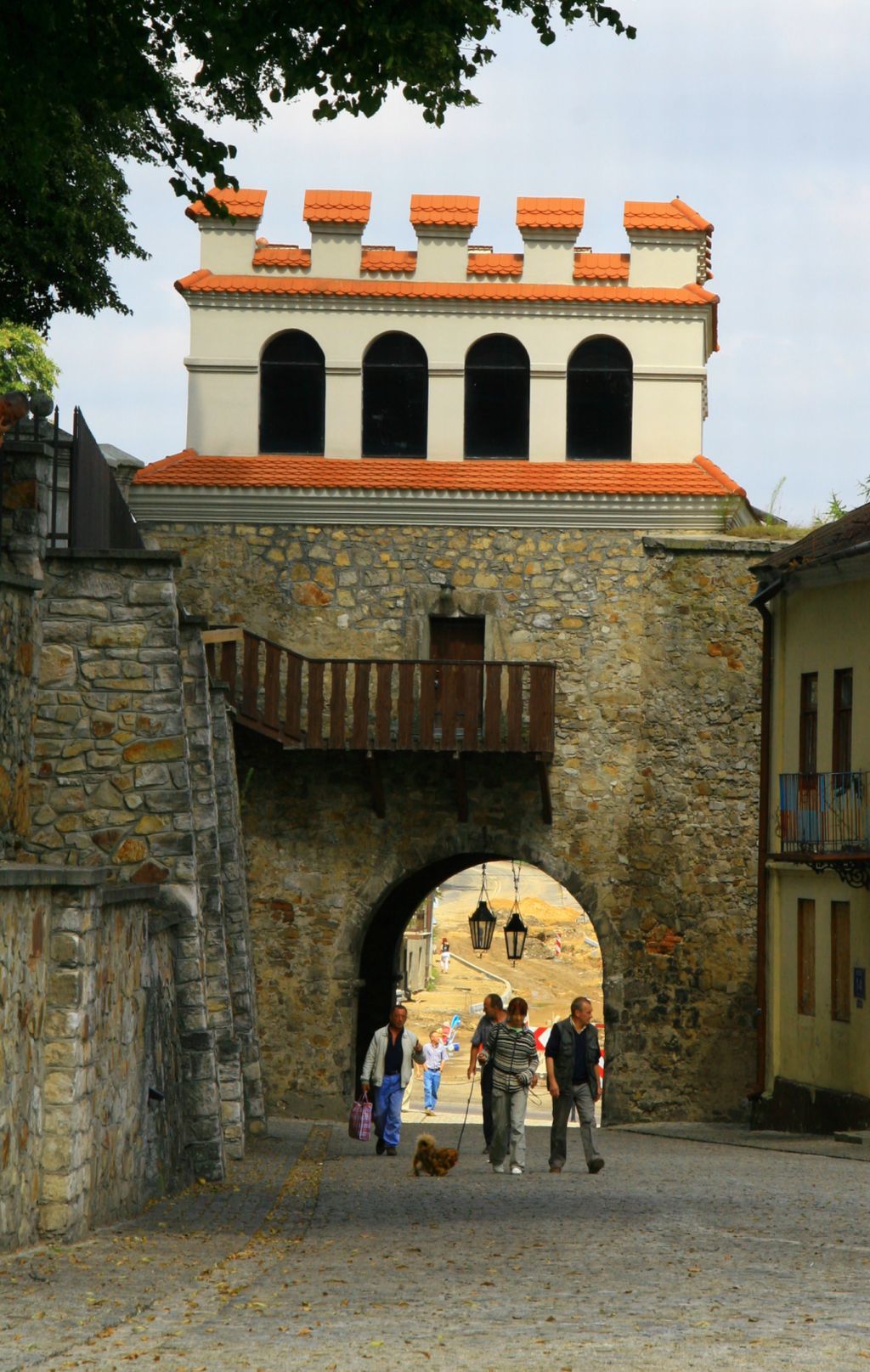 fot.
fot. But soon it was reconstructed thanks to the support of king Aleksander Jagiellończyk (Alexander the Jagiellon). Chancellor Krzysztof Szydłowiecki bought Opatów from the bishops at the beginning of the 16th century and had town walls built with four gates leading to Cracow, Sandomierz, Lublin and Warsaw. He also ordered the construction of the town hall and a water-supply system. After his death the town subsequently passed into hands of the Tarnowski, Wiśniowiecki, Lubomirski, and Potocki noble families. During centuries Opatów played an important role in the country"s public life, frequently visited by Polish royalties. Here queen Marysieńka Sobieska was waiting for her husband, king Jan III Sobieski, returning from Vienna after the victorious campaign during which Turks were defeated. The Partitions of Poland (19th c.) halted development of the town. Many battles were fought in the region during the January Uprising (1863-65). During one of the major battles near Opatów (21 February 1864), the Cracovian division was defeated, its wounded commander Ludwik Zwierzdowski captured and two days later executed on the Opatów market square. Many partisan units operated in the region of Opatów during World War II, including the famous Jędrusie detachment. Worth to see are Warsaw Gate, St Martin the Bishop"s Parish Church-One of the most spectacular examples of Romanesque architecture in Poland, Bernardine Monastery and Church and Underground Tourist Route.
Ptkanów – worth to see is the Gothic Church of Saint Idzi at the turn of the 14. and 15. century. In the second half of the 19. century, it burned and then was rebuilt. The building is oriented, surrounded dating from the 16. century defensive walls with towers and loopholes. On the main altar is placed the image of St. Idzi. The belfry, decorated with motifs phyto frieze - animal served as a bastion. Worth to see is Polish manor house from the 18. century.
Podgrodzie – one can see the ruins of the 14.- century knight"s castle, built on an irregular polygon. The building was built of rubble, from the south and east is surrounded by a moat.
Ćmielów - the little town of Ćmielów is located some 10 km east from Ostrowiec Świętokrzyski, on the boundary of the Iłżeckie Foothills and the Sandomierz Plateau.
 photo Municipal Office in Ćmielów
photo Municipal Office in ĆmielówIt sits on the Kamienna River with a tributary of River Przepaść. Ćmielów is famous for the production of the highest quality porcelain. The Porcelain Factory AS Ćmielów produces porcelain ware with the use of original models and moulds that survived together with the worldwide known traditions of the Ćmielów porcelain products. A logo of Ćmielów Exclusive is now found on the newest products of the Ćmielów factory: porcelain jewelery items. They are all hand-made and hand-decorated. The Live Museum of Porcelain was established on the factory premises in 2005. This unique institution not only displays the factory products, but also let visitors participate in the process of production as well as offer them a chance of making a finished items themselves.
Grzegorzewice - in the village is the church, which consists of two parts: old - Romanesque stone rotunda and the nave from 1624. The oldest part is characteristic of defensive style typical of churches built in the 11th and 12th century walls were built. Over meter thick walls, with small high-placed windows, show a clear, typical Romanesque architecture. The original equipment preserved temple carved in sandstone with the characteristics of Romanesque baptistery. From authentic hole 1627 after rebuilding. preserved today in the southern part of the rotunda is only one small, round large volumes of Romanesque art, with an interesting four-leaves clearance inside.
Dębno – worth to see is a medieval small rampart, located on a promontory of the loess terraces on Pokrzywianka river. Here were found the remains of wooden buildings. In the Middle Ages there was the 14. century manor house of bishops, destroyed about 1370.
Bodzentyn - The little town of Bodzentyn came into being through the urban settlement translocation from the nearby Tarczek by the Cracovian (Kraków) bishop Jan Bodzanta between 1348 and 1355. A Gothic collegiate church was founded by cardinal Zbigniew Oleśnicki in 1450. The local castle was converted into a palatial residence in the late-16th century. Following the administration reform of 1870, Bodzenty lost its municipal rights and became a village. It regained its former municipal status in 1994. One of the most important monument in Bodzentyn is castle.
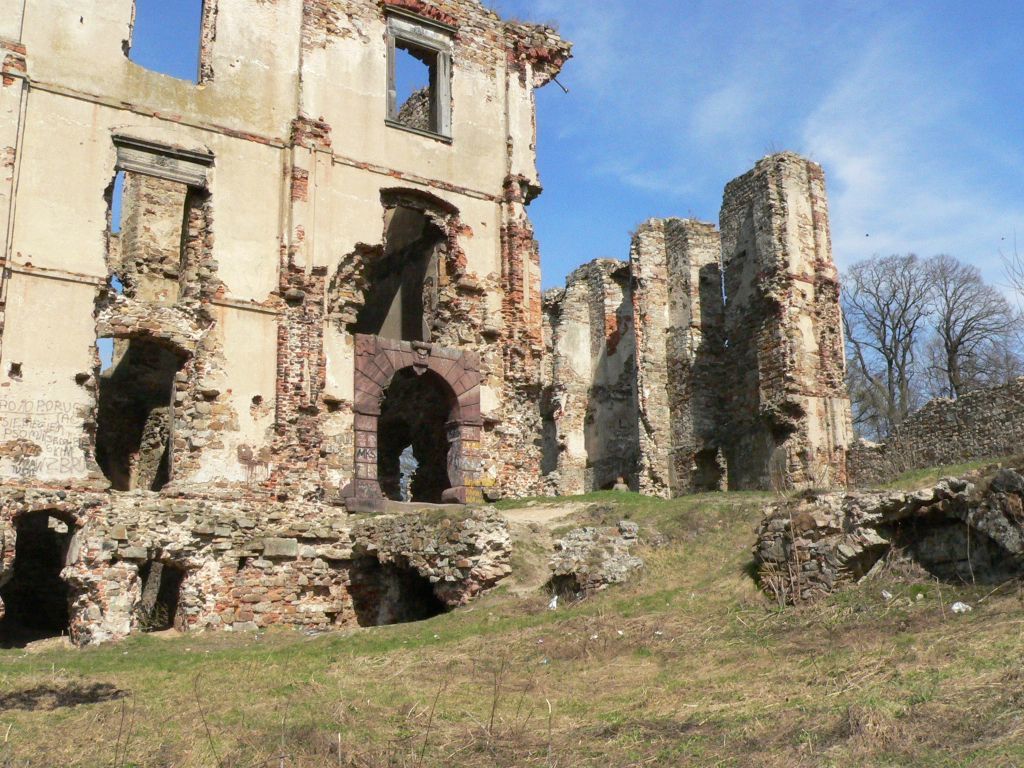 photo M. Brach
photo M. Brach The origins of the castle in Bodzentyn date back to the 14th century, when the Cracovian bishop Jan Bodzanta had a wooden manor built upon River Psarka. This was replaced by a brick castle with moat commissioned by another Cracovian bishop Florian of Mokrsko, and was connected to the town fortifications. Only walls of the castle with window openings survived till today; some of its window openings still have frames with the Nałęcz coat-of-arms on them. Another element relatively well-preserved is a portal made of red sandstone. Worth to see is an example of specific architecture prevailing in little rural towns is a well-preserved farm of the Czernikiewicz family in 3 Maja Street. The mid-17th century the former wooden church was replaced by a brick building of the Church of the Holy Spirit. It functioned as a hospital church till June 1917, when a huge part of the town together with the church were destroyed by fire. Recently, some conservation works have been started on the ruins of the Church of the Holy Spirit. The other monument is the Gothic Collegiate Church of St Stanislaus the Bishop was erected in the years 1440-152, founded by cardinal Zbigniew Oleśnicki. Its nave features late-Renaissance vaults, while the older cross-ribbed vaults are still decorating its sacristy and treasury room. In the presbytery stands a Renaissance alter piece made in 1546, and originally designated for the Wawel Cathedral. Rich decorations of the church interior include Renaissance tombstones, a splendid early-Renaissance painting on wood known as the Bodzentyn Triptych (1508), a Gothic sculpture of Madonna with Child (ca. 1430), and a late-Gothic baptismal font.
Kielce - the town rapidly develops in the early Middle Ages. Many forging workshops and ironworks are built around the town in the 14th century; their production based on the local deposits of iron ore. In 1816 Kielce became an important center of administration in the Kingdom of Poland. At that time mining and metallurgical industry grew in importance. It was in Kielce that Stanisław Staszic established the Main Mining Directorate in 1816. Soon afterwards the Mining Academy was inaugurated. It was the first technical high school in Poland. Good times returned and the city gained many new lodgings, services, paved streets, sewage facilities and public green spaces. In 1867 Kielce became a provincial capital.

New investments were made; a railway line joining Ivanogrod (today Dęblin) with the Dąbrowskie Industrial Center was opened; lime-kilns of Kadzielnia, Wietrznia and Międzygórze were put into operation. In the city worth to see is Baroque Palace of the Cracovian Bishops. Built on a square plan, the main part of this early-Baroque structure occupies the Wzgórze Zamkowe (Castle Hill). Its arcaded front is decorated with three coats-of-arms made of stone: the Korab belonging to bishop Zadzik, the Eagle of the Commonwealth from the Vasa dynasty period, and the Three Crowns of the Cracovian Chapter. Cathedral of the Ascension of the Holy Virgin Mary The highlight of the city"s architecture, the Baroque building of the cathedral retained some Romanesque elements. It faces the Bishops" Palace and stands on the Wzgórze Zamkowe. The first Romanesque church was erected here in 1171. Altered several times during the subsequent centuries, the church acquired its present-day shape in the 19th century. On the other hand, Toy & Entertainment Museum which was set up in the 1970s, it"s the biggest museum of that type in Poland. Its collection of a few thousand toys occupies an area of 700 square meters. The following are the most precious items of the collection: a German wax doll (18th c.), dolls with porcelain heads in costumes from the 19th and 20th centuries, lead soldiers (19th c.), and furnished rooms for dolls. Beside old items, there are also folk toys and modern entertainment exhibits.
More infromation: www.sejmik.kielce.pl

